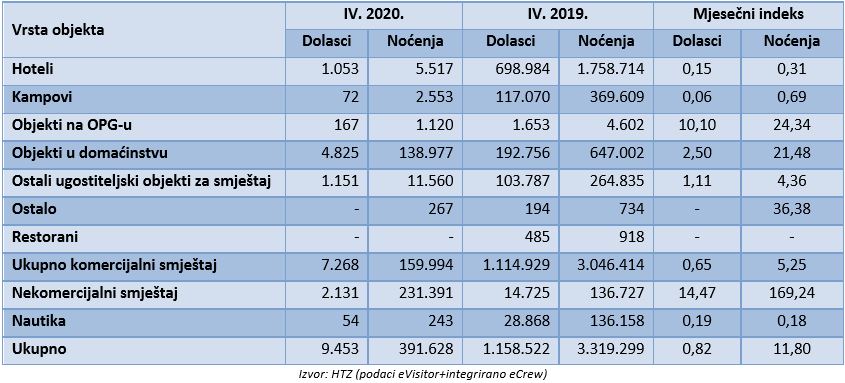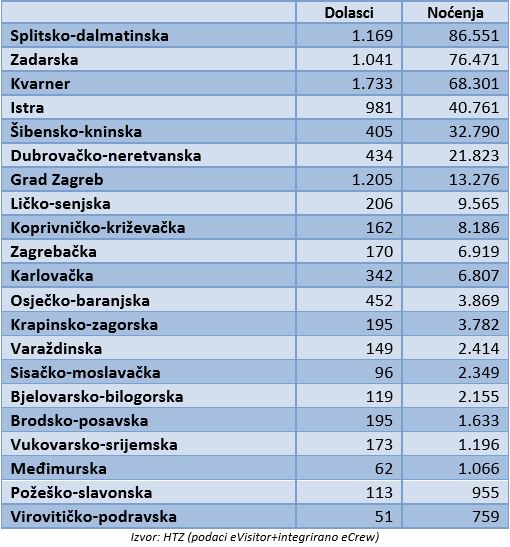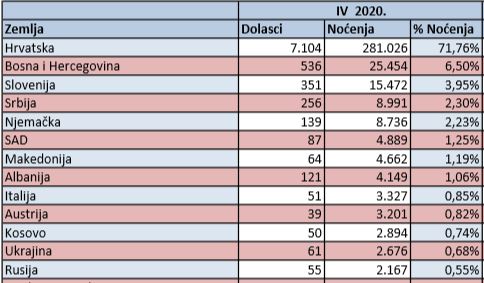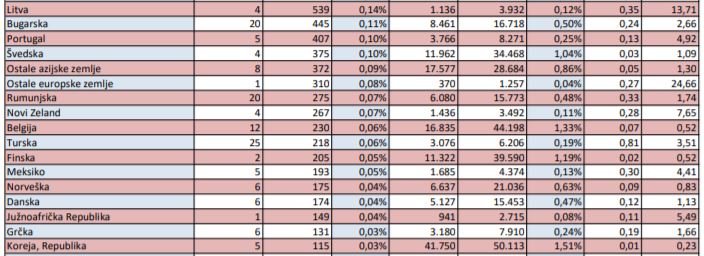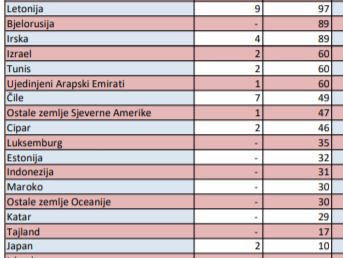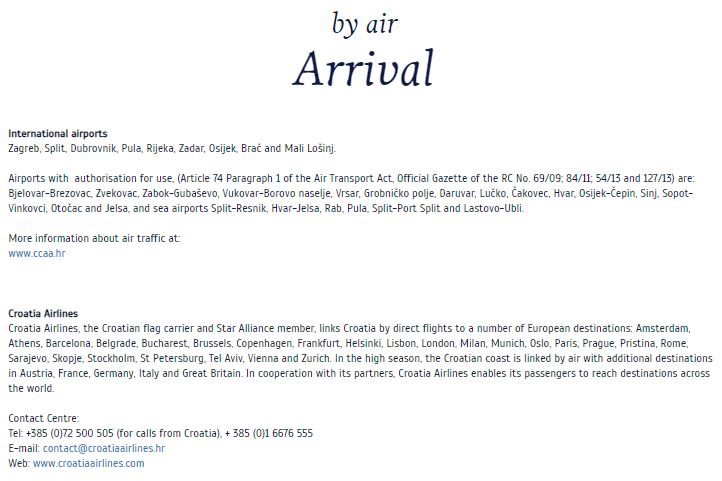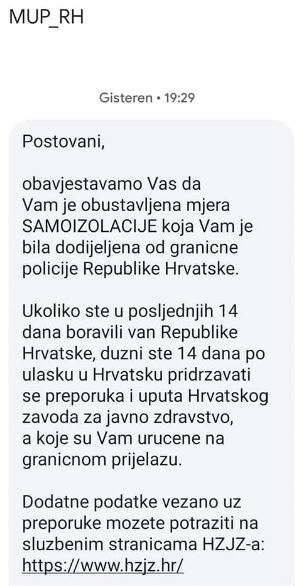Coronavirus: Is Laying Off Staff An Answer? Croatian Economist Talks Maths
Could a shortened working week instead of laying off staff save more money and help the economy get back on its feet in the aftermath of the coronavirus crisis? As the coronavirus pandemic continues to wreak havoc with the global economy, here's an interesting look at the maths, which doesn't support the laying off of employees at all.
As Novac writes on the 13th of May, 2020, Vladimir Benic, an economist and director of the Zagreb company CareerCentar, gave a concrete calculation pointng to the idea that a shortened working week, in which we work three to four days a week only, could save jobs not only the coronavirus era, but in other crises, too. The text he wrote was first published on his LinkedIn profile.
A similar solution was introduced by the Germans, the text says, not as a result of coronavirus-induced economic issues but following the 2008 financial crisis. In order to slow down the growth of the number of unemployed people in Germany, they introduced a measure of subsidised part-time work, better known as ''kurzarbeit''. They thus retained a larger number of part-time employees, instead of laying off 20 percent of the entire German workforce.
We are translating and transmitting his text in its entirety below:
"Figuratively speaking, laying off 200,000 workers would save a company 19 billion kuna a year due to not needing to pay out for those wages. However, once a company reaches pre-crisis levels, it's necessary to restart the recruitment process. Given the cost of hiring people and running the business in the range of 50 percent to 200 percent of the annual salary of workers, companies will thus spend a minimum of 10 billion kuna by re-employing workers. So, the net effect of the company's savings is 9 billion kuna (minus the amount of severance pay the company needed to pay out to those laid off workers).
On the other hand, if companies keep hold of all of those 200,000 workers and reduce their working hours from 40 down to 25 hours per week, that would be save 75,000 workers according to those working hours. Add a 10 percent pay cut to that, and the company would save up to 8.4 billion kuna. In this case, a company would save on the cost that needs to be invested in the re-employment process, and in addition would retain the knowledge and acquired skills of its [retained] employees.
In addition, if we look again at the German scenario, the state could, in the case of retaining workers, help business owners with certain measures to preserve those jobs. If we take into account the positive effect on the state budget in the form of reduced state expenditures for unemployment benefits, the total positive effect of the second business model is greater than 10 billion kuna.
When this image is viewed from the worker’s perspective, the calculation also goes in favour of the second model. For example, the previously mentioned 200,000 workers in a period of one year, with a reduced number of working hours, will see around 6.5 billion kuna left at their disposal.
In this way, they will continue to remain creditworthy, and will change their consumer habits to a lesser extent, which will continue to encourage the development of the economy. On the other hand, if the same number of workers lose their jobs, they will have around 5.5 billion kuna at their disposal, or one billion kuna less for consumption, which will lead to the slower recovery of the [economy of] the country.''
Make sure to follow our lifestyle page for more. Stay up to date with our dedicated section for all you need to know about the coronavirus pandemic in relation to Croatia.
Zagreb Company Creates First Croatian On Demand Video Platform
As Lucija Spiljak/Poslovni Dnevnik writes on the 13th of May, 2020, video-on-demand platforms are the fastest growing way to use audiovisual content, and during the time of the ongoing coronavirus pandemic, they recorded a significant increase in traffic. This gave one innovative Zagreb company a boost.
Here in Croatia, Netflix, HBOgo and Amazon are by far the most popular VOD (video on demand) platforms, but over time, some specialised ones have found their place among the competition, including the aforementioned giants.
One of them is Svevid, the first Croatian on demand platform that started operating in early May via the website www.svevid.net, created by a Zagreb company. The Croatian platform will more than likely bring a smile to the faces of all fans of Croatian and regional cinema with film titles from the former Yugoslavia from the 1940s until the present day.
Svevid is SVOD (subscriptional video on demand), which means that the user accesses the complete offer of content according to the subscriber model, and not on the basis of individual transactions (TVOD) for each title. The service is provided according to the model of monthly, semi-annual and annual subscriptions, and by choosing larger packages, the user manages to rack up some rather significant savings.
Registration starts at a mere four euros per month, and by activating the subscription, the user is given a trial period of two weeks within which they can cancel the service should they so wish, and without any obligation. As explained from this Zagreb company's David Slaj, the Svevid platform is intended for everyone who appreciates and follows regional cinema and those who want to get better acquainted with it. It is currently available in Croatia, Slovenia, Serbia, Bosnia and Herzegovina, Northern Macedonia and Montenegro.
"In our ever-growing catalog, we offer content that originated exclusively in the countries of the former Yugoslavia, from the beginnings of cinema in this area right up until today. We offer titles in the best available picture and sound quality, and we're working intensively on the implementation of multilingual support for all of our content.
The Svevid platform is specific in that our goal is to promote regional production and local creators. We paid a lot of attention to the accompanying content of the catalog, in collaboration with film critic Nenad Polimac, to provide users with the historical and spatial context of everything they watch,'' explained Slaj, adding that their goal was not to take advantage of the coronavirus crisis, but instead to merely speed up their product launches and further optimise their platform to provide customers with the highest quality service.
The team that came together within this Zagreb company and embark on this project mostly come from creative backgrounds and the audiovisual sector. The core team consists of five people, divided into creative and executive segments - David Slaj, founder and CEO Filip Lozic, CAO Danijel Popovic, CFO Inga Lozic and creative manager Luna Zimic Mijovic. They collaborate with a dozen other external associates in the marketing, design and systems support sectors. All of them, according to Slaj, have worked on numerous independent productions for the last five or more years, which has additionally encouraged them to think about the placement and visibility of these works.
According to market research conducted internally, the average user in Croatia actively uses at least two VOD platforms, and there is a significant decline in the viewership of conventional television channels. Furthermore, as Slaj explained, users are increasingly turning to the possibilities that VOD platforms provide them, which is to control when, how much and what sort of content they consume.
"Another significant advantage provided by the VOD platform is that the content is not intermittent and saturated with promotional messages and advertising blocks, which users point out as one of the most important features when choosing a service," noted Slaj.
The name and theme of the whole platform comes from Slavic mythology. Svevid or Svantevid is the oldest Slavic deity, deeply rooted in a common cultural heritage.
"Our market segment counts about 40,000 households in each country in which we operate, which puts numerous challenges in our path, as well as numerous opportunities in the years to come," concluded Slaj.
For more, follow Made in Croatia.
There are 41 Days in April in the Kingdom of Accidental Tourism
May 14, 2020 - One way to boost tourism is to prolong the season. The brilliant minds running the Kingdom of Accidental Tourism have a smarter solution - create more days in a month. 41 days in April for example. And then get tourists to spend the night in Croatia without visiting. Pure genius!
Last night, the Croatian media reported on the official tourism numbers for April. Terrible numbers were inevitable, there is no chance of bringing tourists across closed borders during a pandemic. But the numbers were sensational, and hardly anyone has noticed until now. When I first saw the numbers, I assumed some journalist had mistakenly put in an extra digit and the rest had blindly copied. Here is how HINA announced the numbers:
ZAGREB, May 13 (Hina) - There were 9,500 tourists in Croatia in April 2020, generating 392,000 overnight stays, which is a drop of 99 and 88 percent on the year respectively, according to data from eVisitor and the Croatian National Tourist Board.
That's a lot of overnights for less than 10,000 tourists, I thought. But just as tourists cannot come in, those who are here cannot get out so easily, so it kind of made sense that most tourists were overnighting. I have never been good at maths, but my 11-year-old daughter is a maths genius.
"How much is 9,500 times 30?"
"Just a sec, Dad. It is 285,000."
So with 9,500 tourists sleeping every night in April is 285,000 nights. And yet in the Kingdom of Accidental Tourism, we managed to rack up an impressive 392,000 nights. Another calculation, and it seems that the month of April has 41 days in our beautiful kingdom.
This had to be a journalist mistake, right?
Wrong.
I went to the Croatian National Tourist Board official website to check the statistics directly. HINA had rounded the numbers up slightly, but there is was - 9,453 arrivals, generating 391,628. Which means that there are at least 41 days in the month of April in the Kingdom of Accidental Tourism.
And if you were lucky enough to host a tourist in the 'Nekomercijalni smjestaj' (non-commercial accommodation), April was a great month, for guests averaged over 110 nights each in the 30-day month of April.
Guests in Split Dalmatia slept for an average of 74 nights in April, closely followed by Zadar at 73 nights.
So who are our marathon overnighters? According to our award-winning eVisitor system, over 70% were locals (understandable) who managed about 40 nights between them (not so understandable).
Bosnians were dedicated overnighters in total nights, but managed only 47 overnights in April, which was nothing compared to the average Italian who spent more than two nights in Croatia every night in April at 67.
But the REAL heroes...
Let's hear it for the 4 Latvians who managed an impressive 136 overnights each between them. There may have only been one South African tourist in all Croatia in April, but it was a good one. At 149 overnight stays, our bold South African guest was one night short of sleep 5 nights for every night in April.
But the best was yet to come. For the Kings recently launched a campaign called Croatia Long Distance Love. You can see the first video above. I, like many others, assumed that the point of the campaign was to remind future travellers of Croatia's beauty and to entice them to visit at a later date.
It seems I was wrong, as the big data never lies.
For many years, there has been a popular saying in Croatia, whenever examples of bad service or tourism experiences are mentioned. - tell the tourists to stay home and just send the money.
But the data shows us that the Kings have achieved something quite remarkable this last month, at the height of a global pandemic. For the tourists are staying at home and sending the money.
How else to explain zero tourists from Belarus, but 89 overnights. Or 35 from Luxemburg, 32 from Estonia (must be something to do that Estonian digital prowess, perhaps?), 31 from Indonesia, 30 from Morocco, 29 from Qatar, and 17 from Thailand.
Impressive stuff!
I am not an expert, but perhaps there is a mistake in the data entry. It is not a major issue, as tourism is quiet and this will be easy to fix. But imagine if this happened in a country whose sole strategy and measure of success is numbers, numbers, numbers. How reliable is the data we have been served up all these years? Thankfully we live in Croatia, where there is a proper strategy, and nobody ever talks about numbers, numbers, numbers.
But perhaps there is a perfectly reasonable explanation, so I will write to the tourist board to enquire. Now that they have finished this exhaustive update of the statistics, I might also check on their plans to update the information on how to fly to Croatia.
For the latest from the Mighty State of Uhljebistan, follow our dedicated Uhljeb section.
Analysis: Coronavirus in Croatia Compared to Other European Countries — May 13 Update
May 13, 2020 — Here’s another analysis of the situation in Croatia in relation to other EU member states as of May 11.
The central place for all information about coronavirus in Croatia is koronavirus.hr.
You can find some good visualizations of the pandemic in Croatia on the visualization of the coronavirus pandemic in Croatia Mireo and the visualization of the coronavirus pandemic in Croatia Velebit.ai.
A graphical representation of the number of deaths from or with SARS-CoV-2 virus per million inhabitants per country places Croatia among the five best-positioned countries, with the lowest proportional number of victims (the source is the Johns Hopkins University coronavirus database). Along with Croatia, there are Greece, Poland, Bulgaria and — according to available data, the most successful — Slovakia. The next group with a lower mortality rate is the Czech Republic, Norway, Hungary, Estonia, Finland, Slovenia and Romania. The worst has hit Belgium, Spain, Italy, and the UK. Compared to Croatia, due to its approach to measures to combat the epidemic, the often mentioned Sweden has about 15 times the number of victims per million inhabitants. Belgium has as many as 34 times more victims per million inhabitants.
Mentioning only the absolute numbers of registered infected persons or persons who have died from or in the presence of a new coronavirus by country does not give a true picture of the situation, given that there are huge differences in the population of individual countries. For example, Belgium with its 11.5 million inhabitants has 8,707 victims so far, while Italy with 60.5 million inhabitants has 30,739 victims, but Belgium has as many as 48% more victims per million inhabitants than Italy.
It can also seem that Germany with 7,569 deaths has a lot more victims than Sweden with 3,256, and in fact, the per million population Germany has 72% fewer victims than Sweden.
If we look at the state of the number of registered infected people on the same date, regardless of the onset of the epidemic in each country, as shown in the following figure, it is difficult to compare the development of the epidemic by country in parallel.
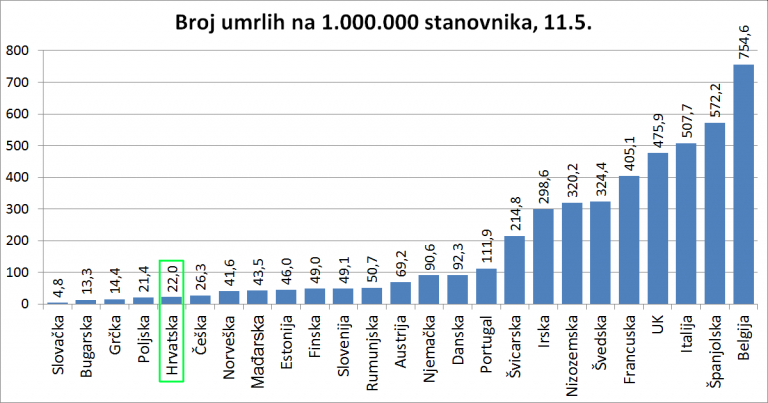
Mentioning only the absolute numbers of registered infected persons or persons who have died from or in the presence of a new coronavirus by country does not give a true picture of the situation, given that there are huge differences in the population of individual countries.
For example, Belgium with its 11.5 million inhabitants has 8,707 victims so far, while Italy with 60.5 million inhabitants has 30,739 victims, but Belgium has as many as 48% more victims per million inhabitants than Italy. It can also seem that Germany with 7,569 deaths has a lot more victims than Sweden with 3,256. In fact, per million Germany has 72% fewer victims than Sweden.
If we look at the state of the number of registered infected people on the same date, regardless of the onset of the epidemic in each country, as shown in the following figure, it is difficult to compare the development of the epidemic by country in parallel. The slope of an individual curve in a period speaks of the speed of the spread of the epidemic, as far as can be determined from confirmed infections. We do not know the number of unregistered infected people.
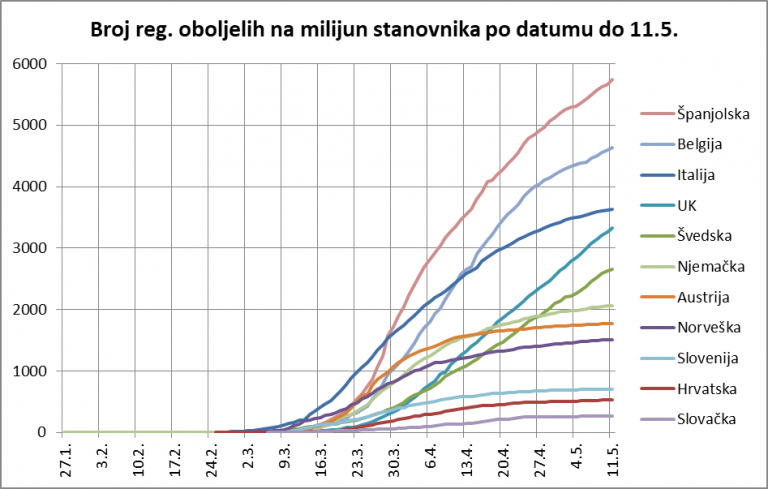
It can be seen that among the observed countries the epidemic first broke out in Italy. However, the growth in the number of patients in Spain (about a week later) was much faster than in Italy.
The number of patients in Italy grew to one million on March 30. Spain has the highest number of cases per million inhabitants among the observed countries, and the curve is just beginning to show a significant reduction in the epidemic.
The second fastest-spreading epidemic is Belgium, with a slightly lower growth rate than Spain, also with more significant signs of calming just begun last week. Italy, the third-largest country in terms of population per million inhabitants, has shown signs of calming down in the past three weeks.
The next two countries that currently have linear curves with no signs of calming down are the United Kingdom and Sweden. Sweden surpassed the number of registered cases per million inhabitants in Germany in early May, and will soon reach the number registered in Italy. Their own research indicates the likelihood of a large proportion of the population being infected but confirmed.
Slovakia and Croatia have had excellent control of the epidemic from the outset, and Austria, Norway, and Germany have successfully calmed the rapid growth that occurred in the week of March 23.
In the following chart, we offer an overview that begins for each country with the date when the infected person was first confirmed in that country. In this way, it is possible to compare the development and effects of epidemic control both in dynamics and in relative numbers per million inhabitants.
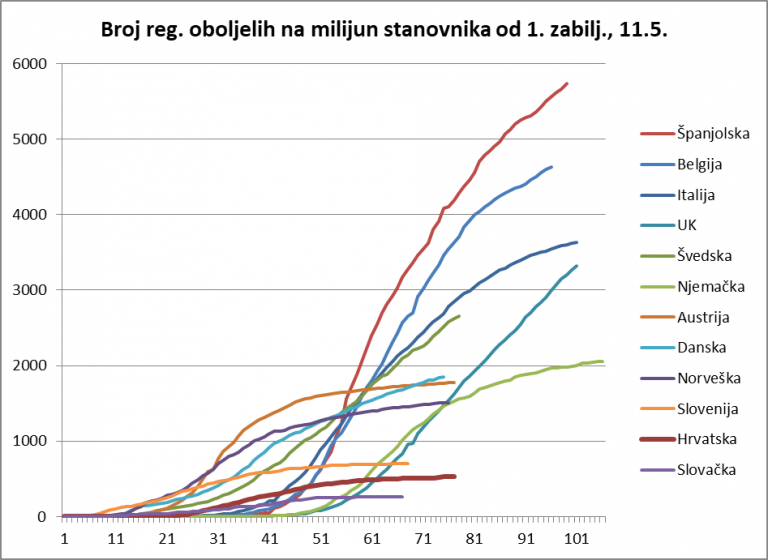
At first glance, two groups stand out among the observed countries. The left group is the one in which the epidemic developed relatively quickly after the first registered infected person in relation to the population: Austria, Norway, Denmark, Sweden, Croatia, and Slovakia. These are countries with a smaller population. The right group is the one in which more time has passed since the first registration of the infected person and these are countries with a larger population.
The first group shows a sharp increase in the number of infected in Austria, but also a very rapid reaction that reversed the course of the epidemic around the 32nd day, and even without "leveling" immediately achieved a consistent reduction in the number of newly infected. The epidemic has calmed down after about 50 days in Austria which, of course, has a big impact on deciding on further measures. The growth rate of the number of infected people from the 51st week is actually the same as in Croatia, except that in Croatia there is a significantly smaller number of patients.
The epidemic in Norway had a similar course with an even more abrupt start, but apparently with a quick reaction of the authorities, who reversed the trend also around the 32nd day and achieved a calming of the epidemic around the 45th day.
In Denmark, the epidemic began very similarly to Norway, the first calming occurred even faster, but after that, the linear growth continued at a rate higher than in Austria and Norway, and on the 70th day Denmark exceeded the number of registered cases per million inhabitants in Austria.
The same group is followed by Sweden, which initially did not have a sharp increase, but on the 55th day, it outgrew Denmark, Norway, and Austria in the number of registered infected persons. On the 66th day, it caught up with Germany, roughly following the development of the epidemic in Italy.
Seen in this chart, Croatia and Slovakia have maintained a very low slope curve almost from the beginning and have the lowest number of registered infected persons per million inhabitants.
In the group of larger countries, it is evident that the most difficult situation is in Spain, which after exponential growth until the 56th day of the epidemic on its territory managed to achieve linear growth first with a stronger slope, and then from about 62 days with a slightly milder but still large slope. Signs of calming the epidemic the week before last were somewhat disrupted last week.
It is similar in Belgium, which straightened the curve around day 54, but has since maintained a uniform but high (relative) increase in new infections with signs of calming the week before last, but a re-emergence of the epidemic last week.
Italy, whose exponential curve started about a week before the one in Spain, achieved a more moderate slope of the linear part of the curve around day 49 and shows a slight but continuous calming of the epidemic after about 81 days.
With a certain time lag relative to the first registered infected person, Germany achieved a curve similar to Austria with a change of trend around the 68th day, but its growth rate of the number of infected in the last part of the curve is still higher than in Austria.
The United Kingdom managed to straighten the curve after exponential growth around the 70th day, but to this day without any sign of calming down. With this increase in new cases, they will quickly catch up with Italy.
If we take a closer look at Sweden we can see a form of exponential growth in the number of infected that has turned into a linear one in the last three weeks.
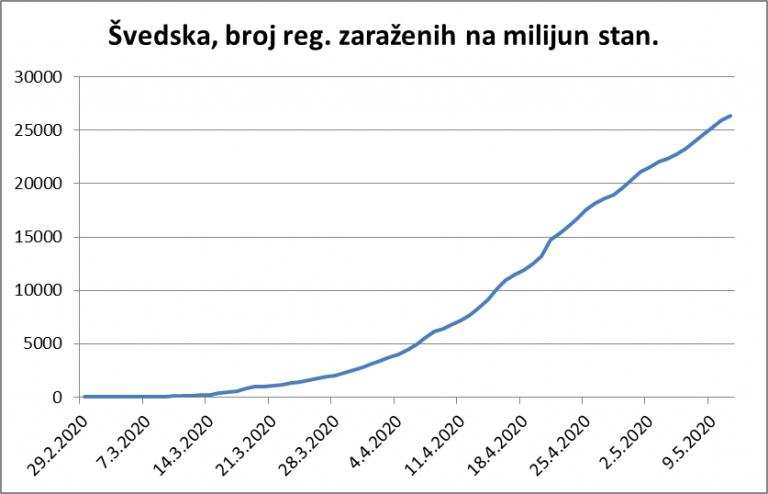
The following graphs will compare the dynamics of the epidemic by individual countries.
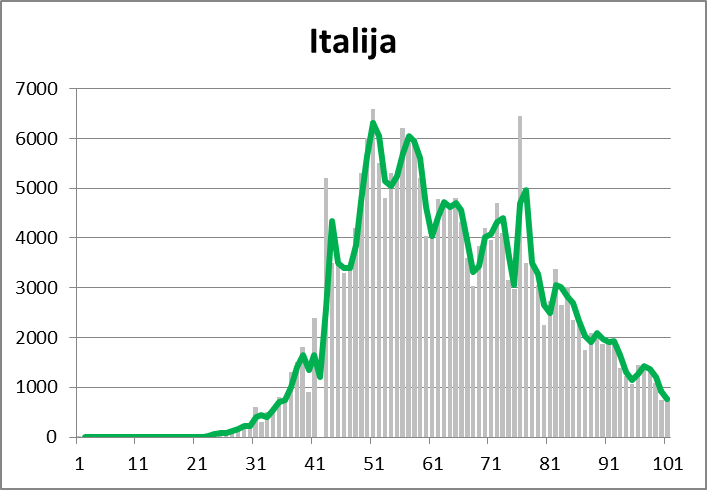
The curve shows in a different way a sharp daily increase in the number of newly registered patients until about the 50th day and then a very uniform and controlled calming.
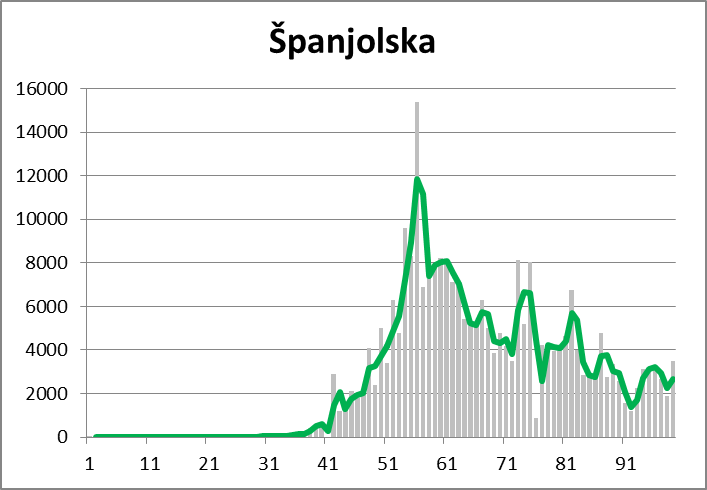
Spain, after an incredibly rapid spread of the epidemic, which reached as many as 15,400 newly infected on the 56th day, is very slowly lowering that number, and in the last week, this trend has been reversed.
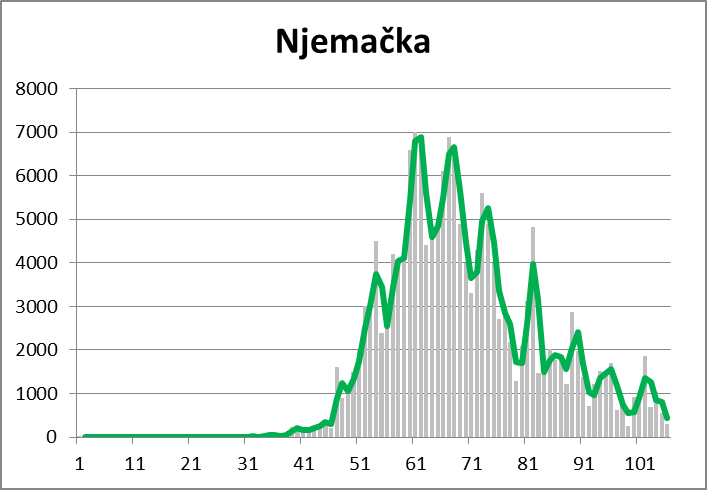
As can be seen in previous charts on the epidemic, Germany has very successfully reduced the number of new infections after reaching a peak between days 61 and 68, with the trend deteriorating slightly last week.
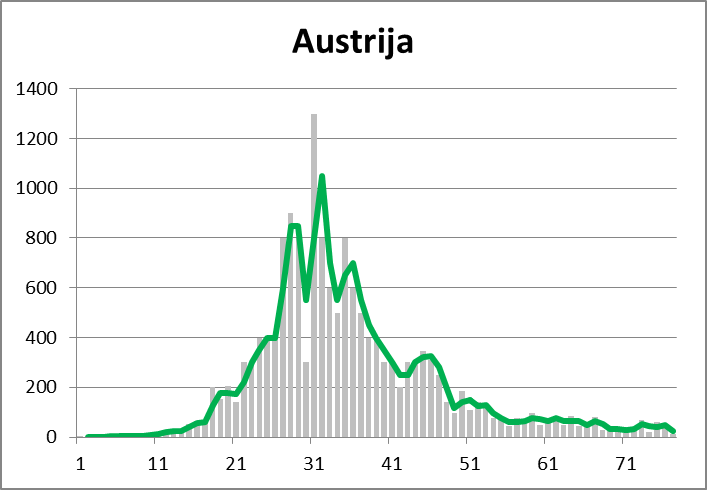
And this chart shows that Austria managed to stop and calm the epidemic very quickly.
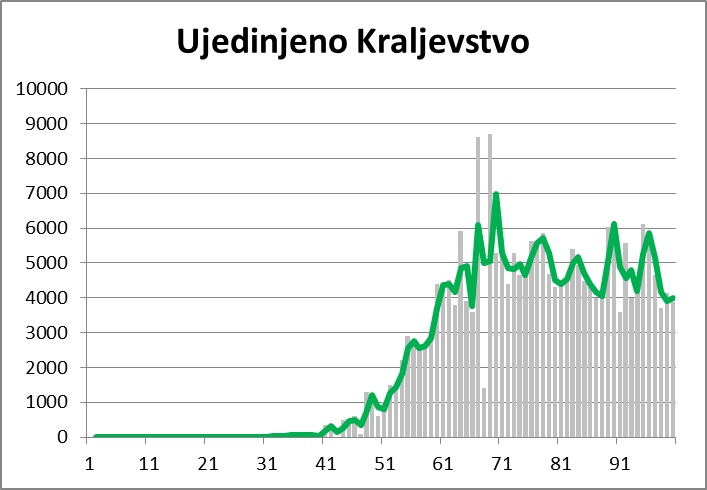
This chart contributes to the understanding of the UK curve as shown in the previous summary charts. After the exponential growth has stopped, the daily number of confirmed new infections is practically the same, about 5,000 per day, and there are no indications of a decrease.
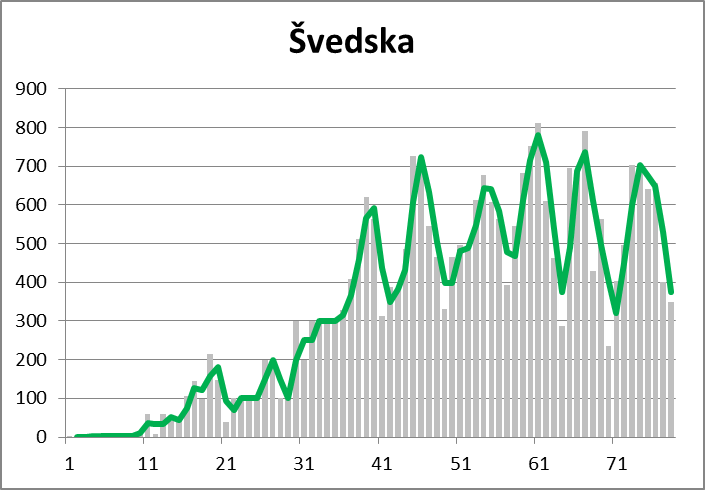
Similarly, the curve of the daily number of newly infected in Sweden otherwise shows the linear growth as shown in Figures 2 and 3, with the caveat that in this case an interesting approximately weekly periodicity is recognized.
Although the following graphs do not show exactly R0 (an epidemiological statistical indicator that indicates how much one infected person infects other people in a given period), very similar information can be read from them. The last three weeks are shown. The situation is all the more favorable because the daily value is no more than 1, and all the more unfavorable because this value is higher than 1. Accordingly, the trend indicators are colored in green (a favorable period when the epidemic subsides), yellow (threatening period around 1), and red (an unfavorable period when the epidemic spreads). The longer the red period compared to the green, the more unfavorable the situation.
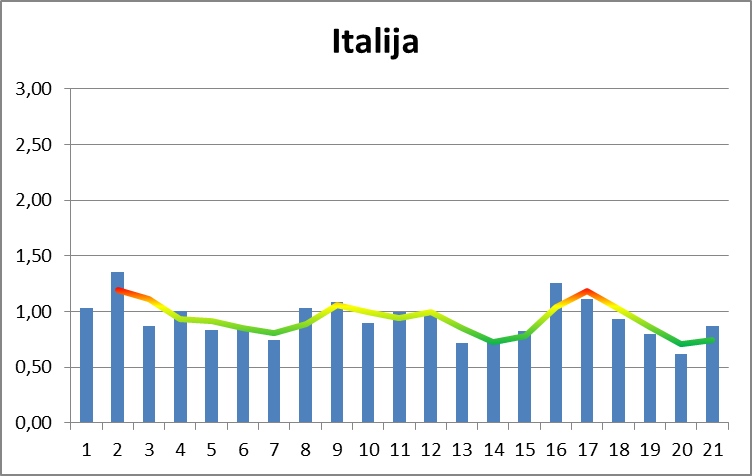
It can be seen that in Italy most of the time the curve is in the green area, which corresponds to the behavior of the curve in Figures 2 and 3, ie the trend of the epidemic subsiding.
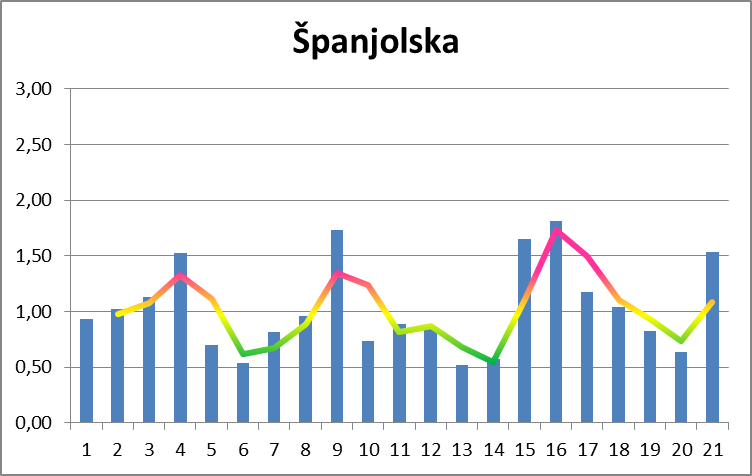
In Spain, this curve goes into the red area a lot, reaching over 1.5, which means that at that moment, two infected people infect three others.
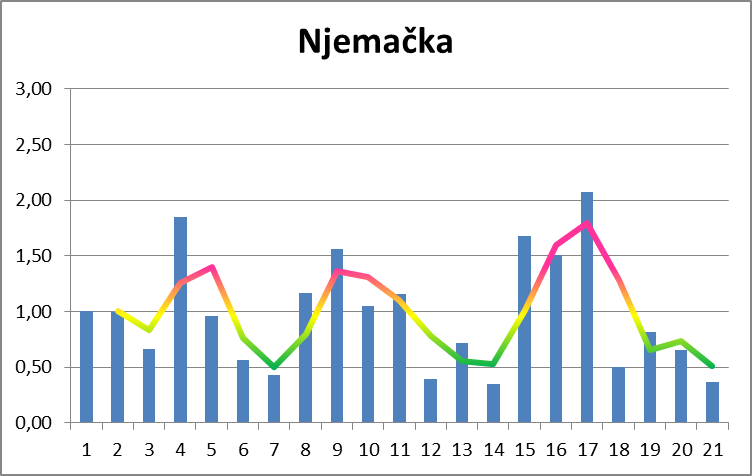
As German officials themselves have warned, the situation in Germany has deteriorated somewhat in the last week, as can be seen in this chart.
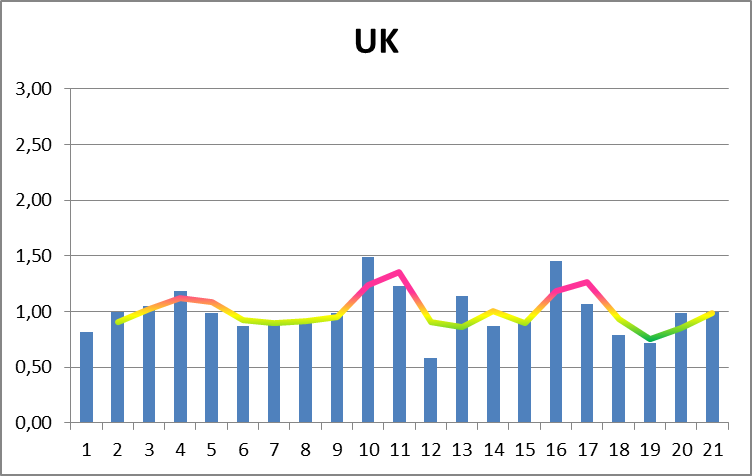
The situation in the UK is not good. The indicator generally ranges around 1, goes very weakly into the green, and more strongly into the red area. Therefore, the curve on the comparison charts for the UK is dire.
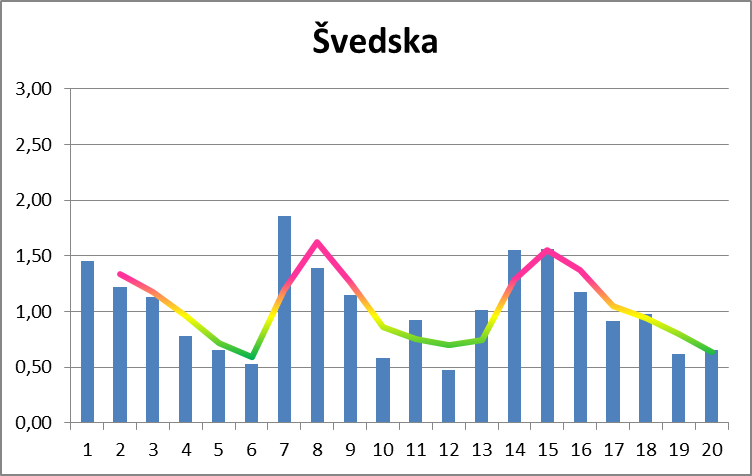
Sweden also shows variations in this presentation, and it can be seen that the indicator "spends" approximately the same amount of time in the green and yellow areas, which means that on average it is around 1.
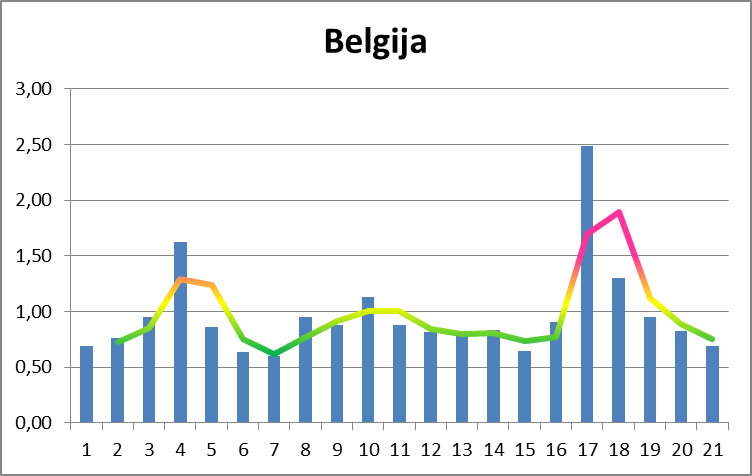
This graph also indicates that a major epidemic breakthrough has taken place in Belgium in the last week, and the previous two weeks are not particularly optimistic either, as the indicator was mostly around 1.
If we take a closer look at Croatia, we will see that the linear growth was already achieved around 22.3. (immediately after the earthquake in Zagreb), that an even better slope was achieved after 1.4., and that from 16.4. achieves a very successful calming of the epidemic. It could also be statistically concluded that the average recovery time of registered patients is between 3 and 3.5 weeks.
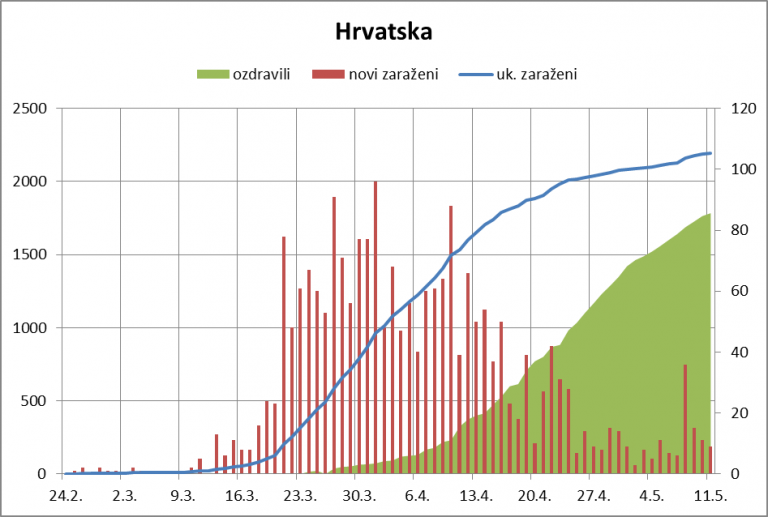
On the blue curve, it is easy to see how the high daily increment shown in the red columns after May 8, when the breakthrough on Brač was determined, is reflected.
An excellent general result of Croatia can also be seen in the graph showing the movement of the number of patients. This curve significantly reduces the pressure for health facilities, so it can slowly return the entire health system to normal when it performs all its functions.
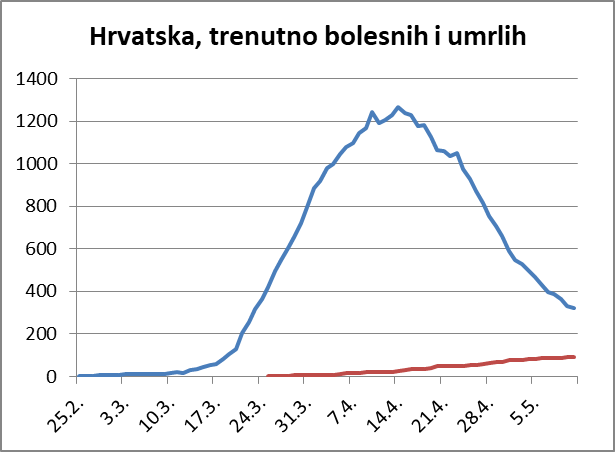
In these topics, the question often arises as to what is a good measure in testing and whether we test enough. An excellent graphical representation of the ratio of testing per million inhabitants to the percentage of positives shows who tests optimally and who does not at all. If you are around and below 10% positive, you have found a good measure - Croatia is.

When you look at the overall picture and compare it with other countries, you can clearly see that Croatian epidemiologists have excellent control of the epidemic. It is now up to other experts to make the best use of this favorable situation for the benefit of Croatian citizens.
Others rightly rank Croatia among the countries that have successfully defeated the coronavirus.
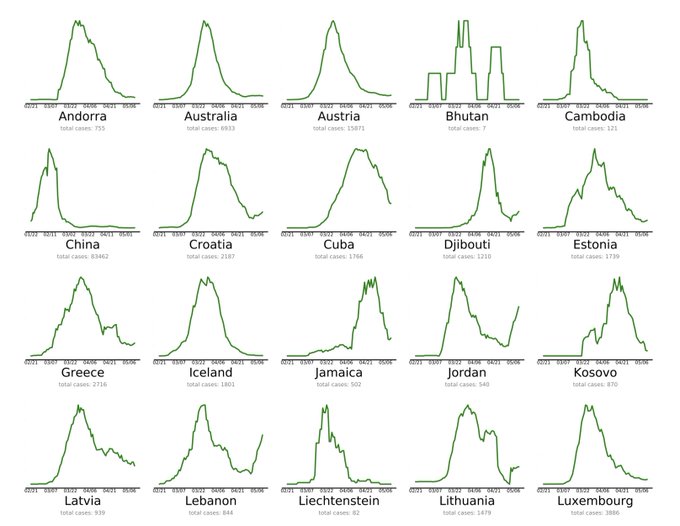
Given that decisions on crisis management, especially in the phase of easing anti-epidemiological measures, are not only health but also political, further careful monitoring of the situation and comparison with political decisions and health outcomes in other countries is needed.
Of course, every country can ask itself what its long-term perspective is in these new circumstances that will not disappear. States, which have curbed the epidemic in the sense that they have ensured that their health system can control the situation, develop further strategy than those who still have to make every effort to maintain the functionality of the health system.
In all this, it is necessary to take care of the economic consequences of the crisis - lower estimates of the fall in GDP by EU member states. Due to excessive exposure to tourism, Croatia is unfortunately at the very top.
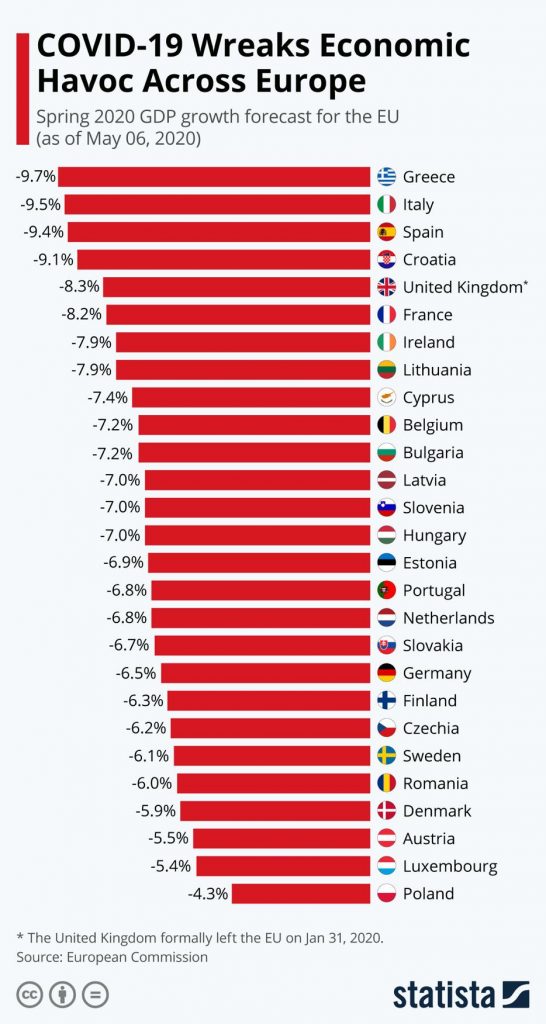
Politics 1 Health 0: Is Croatia about to Throw It All Away?
May 13, 2020 - Politics 1 Health 0. With the tourist season due to start and elections approaching, the surprising realities on the ground in Croatia in the battle against COVID-19.
As we have reported since late January, Croatia has done an excellent job containing the coronavirus, both in terms of effective measures, and in clear and transparent communication. We are all grateful for the extraordinary efforts of Vili and Alemka and the rest of the team. Heroes all.
The initial focus of dealing with the disease was health, health, health. It did not take long, however, for the sheer enormity of the economic consequences to come into the equation. The debate shifted from health protection to one with two camps - one advocating lockdown and health protection at all costs, the other advocating a relaxing of measures to allow the economy to breathe, people to earn a living and avert economic catastrophe.
And this being Croatia, it did not take long for a third factor to come into the equation - one which could well be s bigger deciding factor than the economy and health combined - politics. Parliamentary elections are scheduled for July.
I am not a health expert, and my wife will confirm I am certainly no economic expert, and I have no politics. My opinion doesn't matter, and I long ago wrote that the only two corona voices I listen to are Jurgen Klopp and Igor Rudan.
That is my choice, and I am happy with my choice, and as I don't speak with any authority, I see no reason to foist my opinions on corona on the world, in the same way that I feel I DO have something to contribute to the Croatian tourism and digital nomad debate with my opinions, for example.
What I can do, however, and I think TCN has done a great job, is report on the corona story in Croatia. Especially things that are happening under the radar that people should be aware of.
Croatia relaxed its measures for the third consecutive week on Monday, a move which allowed much more freedom of travel, visits to cafes etc. This is the background and context to my story.
A couple of days ago, we reported on the story of a Belgian called Didier, who managed to drive from Belgium to Gromin Dolac on Hvar during the height of the pandemic. With a residence, business and registered car on Hvar, he was able to get all the permits, on condition that he went into 14-day self-isolation on arrival. My wife's family first started hosting Didier's family almost 50 years ago, and so I know him quite well. He is extremely responsible and also had one of the best self-isolation spots in Europe - his gorgeous Castaway Hvar complex in a remote part of southern Hvar.
Didier wrote a really detailed and fascinating account of his journey from Belgium to Hvar, including details on getting permits, border crossings etc. He arrived on Hvar on May 8, 5 days ago, and he immediately went into self-isolation in his Castaway paradise. The very efficient Hvar police came to check on him the next day to make sure he was in fact observing the self-isolation. All good so far. You can read his account here.
That was five days ago. So it was something of a surprise to see Didier, the responsible Belgian, walking through Jelsa's main square today on his way to the bank. Belgium, remember, has the highest death rate per million in the entire world. And here he was, five days into his 14-day self-isolation. WTF? I know how responsible he is.
He greeted me warmly from distance, informing me that he had received an SMS at 19:29 last night from the Ministry of the Interior informing him that he was no longer required to self-isolate. The SMS is above, the translation below.
Dear Sir, We would like to inform you that the measure of self-isolation given to you by the border police of the Republic of Croatia has been suspended.
If you have been/given the fact that you have been outside of the Republic of Croatia for the last 14 days, you are obliged to follow the recommendations and instructions of the Croatian Institute of Public Health, which were delivered to you at the border crossing, for 14 days after entering Croatia.
You can find additional messages regarding the recommendations on the official website of the CNIPH.
Perhaps the epidemiological advice has changed in the last 4 days, and an arrivee from a country with the highest death rate per capita in the world no longer needs to self-isolate for 14 days.
When it comes to corona knowledge, I am more Jurgen Klopp than Igor Rudan.
And all I can do is report what I see.
For the latest on the coronavirus crisis in Croatia, visit the dedicated TCN section.
Tourism Minister Gari Cappelli Reveals When Croatian Borders Will Open
As Index writes on the 13th of May, 2020, today, the European Commission will make recommendations on the relative re-opening of national borders within the territory of the European Union. Tourism Minister Gari Cappelli in the A sada Vlada (And now the Government) segment on HRT said that all tourism ministers agreed that there should be a protocol at the EU level, but that one should be aware that not everyone is equal when it comes to respective epidemiological situations.
The border with Slovenia should be opened within a few days.
"We expect a good result to come of the bilateral talks we've been holding with Slovenia over recent days because our epidemiological pictures are similar. With this agreement, Slovenes will no longer have to be quarantined for 14 days when they return to the country," Minister Gari Cappelli stated, adding that Croatia is talking to some other countries about opening borders back up, too.
A significant number of Slovenes are expected.
Minister Gari Cappelli also said that when the protocol with Slovenia is resolved, he expects a large number of Slovenian tourists to arrive in Croatia, especially because 110,000 of them have houses in Croatia.
"I'm sure, if the epidemiological situation is in order, that we'll have the arrival of tourists from Germany on June the 15th, at least those coming by road," the minister said.
He emphasised the fact that Croatia had provoked the EU to hurry up with their recommendations on the most important things, and that was, among other things, movement within the EU's borders.
"At the EU level, we've agreed that borders for third countries will not be opened until June the 15th," he said.
"By the end of the month, we'll have a flow with two or three countries, and by June the 15th, we're planning on having that with Germany and some other countries," he said.
Minister Gari Cappelli said there will be discounts for domestic guests this season.
"In this respect, we've also reduced ticket prices for entry into national parks and many domestic tourists visited them. I hereby invite those who decide on the ticket price for the Dubrovnik walls to reduce those prices, because I think a ticket price of 200 kuna in this situation is just absurd,'' he said, adding that this reduction in prices will spill over to accommodation capacities and further.
He emphasised that the Croatian Government has also started with the CRO card, which may not be in full function this year, but that it remains a long-term project.
"Over recent days, we've been talking about additional things we could put on the CRO card, so if we can agree on all of that with employers, hoteliers and agencies so that whoever has this card gets an extra discount, then it will bring the first results," he said, adding that he hopes to there will be understanding for that.
On the topic of Croatia Airlines...
Minister Gari Cappelli pointed out that it had been agreed that Croatia would build air bridges using Croatia Airlines because the south of Croatia has now been completely cut off without air travel.
"We'll use our own airline, and we can now see just how important it is to us because we can dictate the opening of certain routes ourselves," he said, adding that Croatia Airlines would be "worth its weight in gold".
The minister said that he is aware that the new measures have brought new investments and rules for those in hospitality, as well as hoteliers, but that this is something necessary and, as he says, this is a new normal and a new era has come for all of us.
"As for vouchers, Croatia was among the first in the EU to react to the idea. We gave vouchers for travel agencies that are valid for 180 days and can be used for another destination or if you want to go to the same destination but next year, the value of the vouchers is extended, or, if after 180 days you want a refund, then that refund must be completed within 14 days,'' the minister stressed, adding that this is true for agencies, but work is being done to make this the case for hoteliers and for airlines as well.
Minister Gari Cappelli also said that about 10 percent of the usual workforce had been laid off in tourism. He stressed that this season, Croatia intends to work with the domestic workforce to the maximum.
''We'll make a greater effort to retain domestic workers through various measures because they're one of our greatest values,” Minister Cappelli concluded.
For more, follow our travel page.
CEO Eddie Wilson: Ryanair Zadar Base Will Not Go Ahead
May 13, 2020 - Bad news for those depending on the Ryanair Zadar connection from the UK and Ireland, explains CEO Eddie Wilson in a podcast interview.
It was the route which started budget airline travel back in 2007, with the Ryanair Zadar to London Stansted route. The Ryanair Zadar love affair continued for over a decade, and at one point the Irish airline opened its 54th base in the Dalmatian coastal destination.
And then something happened, and perhaps the story will come out at some point.
I have lost count of the number of emails I have received from tourists asking about Ryanair Zadar flights from the UK and Ireland. When the flight ban came in initially, all flights from the UK and Ireland for 2020 disappeared, apart from flights around the Hideout Festival.
And as we reported yesterday, when Ryanair announced yesterday that it planned to resume 40% of its schedule, that included services to all its Croatian partner airports.
Except in the case of Zadar, the only reinstated connections were to mainland European cities such as Milan and Berlin. Nothing at all from the UK and Ireland.
A regular TCN reader sent me a link to a podcast from Ireland, which interviewed Eddie Wilson. The 12-minute interview, which you can listen to here is a wide-ranging and open overview of Ryanair's plans to fly again. At the end, among the questions, was this:
Alan from Wicklow - What about flights to Zadar? They seem to have completely vanished for 2020 and 2021. Is the Ryanair Zadar connection finished? We now have to fly to Split instead.
I think what happened was the Zadar flights were operated by another airline in the Ryanair group, Lauda Air. My understanding is that that base is not going ahead.
We will bring you more news on this story as we get it after contacting Zadar Airport.
For the latest information about flights to Croatia, check out the dedicated TCN section.
Are Croatian Borders Open? Who Can Enter? What Conditions? Are There Flights?
May 13, 2020 - Confusion reigns. Are Croatian borders open for all? Has tourism begun? A look at what we know, and a plan to find out the rest.
One of the great things about living in Croatia is just how surreal life here is, with no two days being the same. Just when you think the country is finally moving forward with cohesion and direction (10/10 to those handling the health aspects of the corona crisis - both in terms of effective measures and communication), you get a reminder that this is The Beautiful Croatia, a country I am beginning to think was the original inspiration for Monty Python.
It is also election season, so the focus is now shifting. Health, health, health was how we started. Then health, health, economy. And now we are health, economy, politics. Time will tell which of those three will determine the decision-making. But a decision has been made that tourism must begin, totally understandable as it is 20% of GDP and the livelihood for many people in Croatia.
There are strong arguments for both sides - yes and no to tourism this year - and my opinion doesn't matter either way. A decision has been made, and now Croatian tourism enters the dogfight to battle for those still planning a holiday this summer. And now that the decision has been made, the next logical step - and something that the Ministry of Health has excelled at - is to communicate the message loudly and clearly.
I have been genuinely swamped with messages asking for advice on who can travel, what is the procedure, are borders open etc. There is unbelievably confusion out there, at a time when Croatian tourism needs to be clear, concise and welcoming. Take, for example, the How to get to Croatia by air page on the Croatian National Tourist Board website. Yes, reallly, check it out yourself.
So what is the official info we have? To their credit, the national tourist board has finally moved away from quoting obscure article numbers from the Official Gazette and actually providing some useful information on its COVID-19 page, even if it took an article from Index.hr to get them to do anything.
The Ministry of Tourism website also has a new feature since Index highlighted the issues - you can find official corona info from the Ministry here.
Minister Cappelli gave an interview recently where he provided some more info, as well as the tourism metaphor of the year in the corona era - Croatia Breathes Tourism.
And Minister of the Interior Bozinovic also gave an interview explaining a lot more.
The information is all over the place, something I decided to point out to the most approachable official in the Ministry of Tourism, State Secretary Tonci Glavina. A man from Klis educated in California, Tonci is bilingual in both language and mindset, and you can see the public exchange yesterday of my request for a platform for more clarify for all our potential guests.
As requested, here are the questions I sent. As soon as I get the answers, I will publish them in a structured article on TCN, and I hope that the ministry and other official bodies will as well.
Croatia had to act decisively to contain the virus, which it did. It now needs to act decisively to salvage what it can of the tourist season. Currently, it is doing anything but.
1. Who can enter Croatia at the moment?
2. New measures have been announced which state that people can come if they have a holiday home here, a residence, some economic reason. It is all a bit vague. Can you explain exactly what the new rules are and when they come into effect?
3. Will borders be open to nationals from every country?
4. Will borders be opened at the same time? There was talk of the Slovenian border opening first for Slovenians only, then Austrians. A definitive list of which borders when and for whom would clear up a lot of confusion.
5. What is the procedure regarding testing and self-isolation? Are tourists required to take a test? If yes, who pays and how much?
6. Do you have arrangements about 14-day isolation with your EU partners returning to their home country after the holiday, or will tourists be required to do this?
7. Are UK nationals still covered by the EU health cover until the end of 2020?
8. Does 'borders open to EU citizens' include people from the UK?
9. What about tourists already in Croatia, whose visas have expired?
10. Which businesses will be allowed to operate on a Sunday during the tourist season?
11. Is there any news on when flights from outside the EU (apart from UK) are scheduled to resume?
12. What are the procedures for people sailing and arriving in Croatia from other countries on the Adriatic?
13. What if I or someone I'm travelling with develops symptoms while on holiday in Croatia?
14. The situation can change rapidly. Do travellers have to worry a spike in new infections in their home country means Croatia prevent them from entering?
For the latest on coronavirus in Croatia, check out the dedicated TCN section.
MUP Announces Return to Semi-Normality for Administrative Police Stations
As Poslovni Dnevnik writes on the 12th of May, 2020, as of the 11th of May, which marks the third phase of Croatia's gradual releasing of its formerly stringent anti-epidemic measures, changes are in effect when it comes to applying for obtaining new government-issued documents such as Croatian ID cards, new passports, driving licenses and various other items, according to MUP.
As of Monday, May the 11th, 2020, MUP has announced that all Croatian police administrations and police stations that also deal with particular administrative affairs are back to working normally and in full scope, but with measures to ensure safety firmly in place for both employees and those needing new documents.
The administrative activities stated in the announcement from the Ministry of the Interior (MUP) relate to the issuance of travel documents/passports, Croatian ID cards and driving licenses, the registration and deregistration of residence and stay, the changing of address, and activities related to the acquisition and legal registration of weapons, status regulation and the issuing of documents and ID cards for legal foreign residents.
In order to follow the epidemiological instructions which remain in place across Croatia in the best way possible, MUP has organised the performance of these administrative tasks in two shifts in accordance with specific circumstances with the fulfillment of all of the prescribed measures implied, and, if necessary, with pre-agreed arrival dates and times between administration employees and people requiring new documents.
''People can be informed about way things are operating in a specific competent police administration or police station and arrange for their arrival or another way of performing that task via e-mail or by calling the publicly available telephone numbers of police administrations and stations,'' states the aforementioned MUP announcement.
For more on MUP, ID cards, gaining residence in Croatia as a foreigner, obtaining citizenship and much more, make sure to stay up to date with our dedicated lifestyle page.
Chops Grill is Back in Business with Special Three-Course Menu
May 13, 2020 - The wait is over... Chops Grill is back in business with a tempting three-course menu!
On Monday, May 11, the National Civil Protection Headquarters allowed Croatian caterers the right to serve their beloved followers again - and as you can imagine, the news was welcomed with open arms.
All of us who missed indulging at our favorite restaurants in Split or sipping coffees in the sun on the Riva are now fully back in action, though, of course, in a much more careful capacity.
Disinfectants are king today, but if that's what it takes to win a seat back at Chops Grill, its safe to say that we're not thinking twice.
To celebrate their return to the Split restaurant scene, Chops is back with a three-course menu that will have the locals drooling.
For starters, you can choose between a leek and potato soup, tuna carpaccio, panzanella salad with skuta cheese, or beef tartare with toast and butter.
The price of the three-course menu is depicted by the main course you choose (from 135 to 275 kuna). For the non-meat eaters in the group, try the beet risotto with skuta cheese or the seafood linguine pasta.
Those of you partial to chicken can savor in the chicken supreme with mashed potatoes, seasonal vegetables and a reduced chicken sauce.
Since Chops specializes in beef, there are a variety of options to choose from, like the beef skewers with vegetables and dried mushrooms, served with roast potatoes, or the 300-gram rump steak stuffed with cheese and pancetta, served with roast potatoes and a blue cheese sauce.
The real winners, however, are the beef wellington, dressed with mashed potatoes and truffles, and the T-bone steak, simply served with roast potatoes.
Because no meal would be complete without dessert, you can choose to end your meal with a creme brulee foam with forest fruits and vanilla, semifreddo, chocolate brownie, or traditional rožata with lavender, rose extract and cream.
What are you waiting for?
For reservations and more info, email This email address is being protected from spambots. You need JavaScript enabled to view it., visit their Facebook page, or call +385 91 365 0000. You can also visit their website here.
To read more about lifestyle in Croatia, follow TCN's dedicated page.

